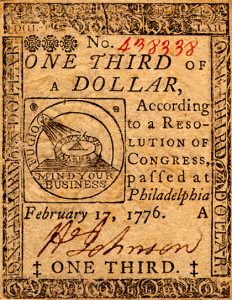Revolutionary Financial Decision: The Birth of Continental Currency and its Impact on American History
Congress issues $2 million in bills of credit.
On June 22nd, 1775, the Continental Congress issued its first paper money on this momentous day. This revolutionary decision was a bold move by the newly formed American government and had far-reaching consequences for all its citizens.
The American colonies were economically disrupted at that time due to the Revolutionary War with Great Britain. The need for a new form of currency emerged as the nation’s economy was in shambles. To meet this need, Congress authorized the issuance of bills of credit to pay military expenses and supply goods to officers and their troops.
The Emergence of Continentals
Although not the first instance of paper currency in the colonies, with the Massachusetts Bay colony having the privilege since 1690, the issuance of Continentals by Congress was a significant event. These revolutionary bills marked a stark departure from the prevailing monetary designs of the time, discarding the portrait of the British monarch in favor of images depicting Revolutionary soldiers and bearing the inscription “The United Colonies.”
The Ineffectiveness of Continentals
Continentals currency fell far short of being an effective financial tool. Being backed solely by the promise of future tax revenues, they became highly susceptible to hyperinflation. As a result, the Continentals held minimal economic worth, burdening the newly formed nation with an overwhelming war debt. The inadequacy of these bills was succinctly summarized by George Washington when he remarked, “A wagonload of currency will hardly purchase a wagonload of provisions.”
Financial Fallout and Economic Instability
The controversial Continental currency precipitated significant financial fallout. Following the Treaty of Paris in 1783, America was thrust into a severe economic depression. The unstable currency and mounting debts led to a rebellion spearheaded by Daniel Shays, a veteran of the Continental Army, in western Massachusetts during the harsh winter of 1787.
The Birth of a Resilient Financial System
As outlined in the federal Constitution, the ensuing economic instability profoundly influenced the decision to abandon the Articles of Confederation in favor of a more robust, centralized government. With the establishment of George Washington’s presidency, the arduous task of establishing financial institutions capable of stabilizing the nation’s economy was entrusted to Alexander Hamilton. Despite its flawed beginnings, this marked the initial steps toward building a resilient financial system in the United States.
Shaping American History
The groundbreaking decision by Congress to issue Continentals in 1775 left an indelible mark on American history. It showcased the determination and resourcefulness of the American revolutionaries in their struggle for independence. While the Continentals proved ineffective as a financial instrument, their shortcomings paved the way for a more robust and stable economic foundation. The subsequent economic depression and rebellion catalyzed the creation of a centralized government and the establishment of financial institutions, underpinning the eventual development of a resilient financial system in the United States.


